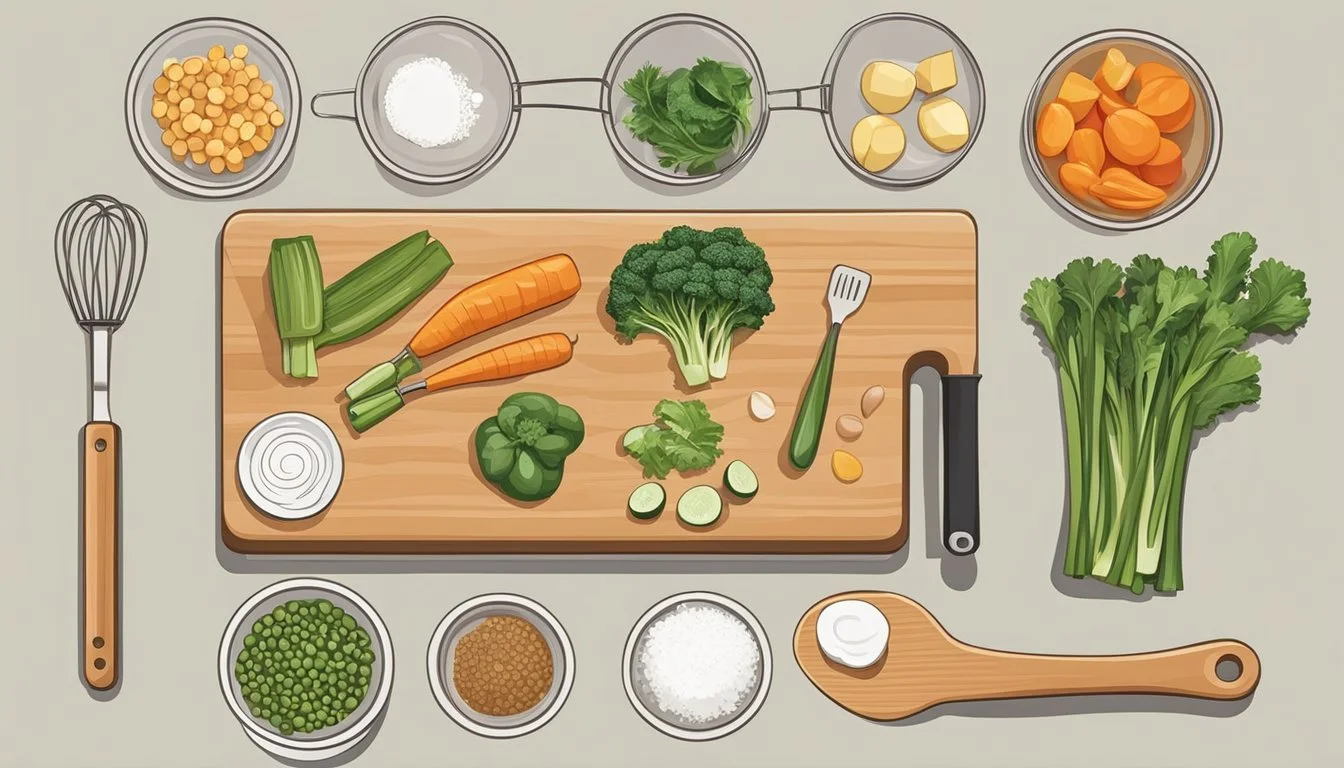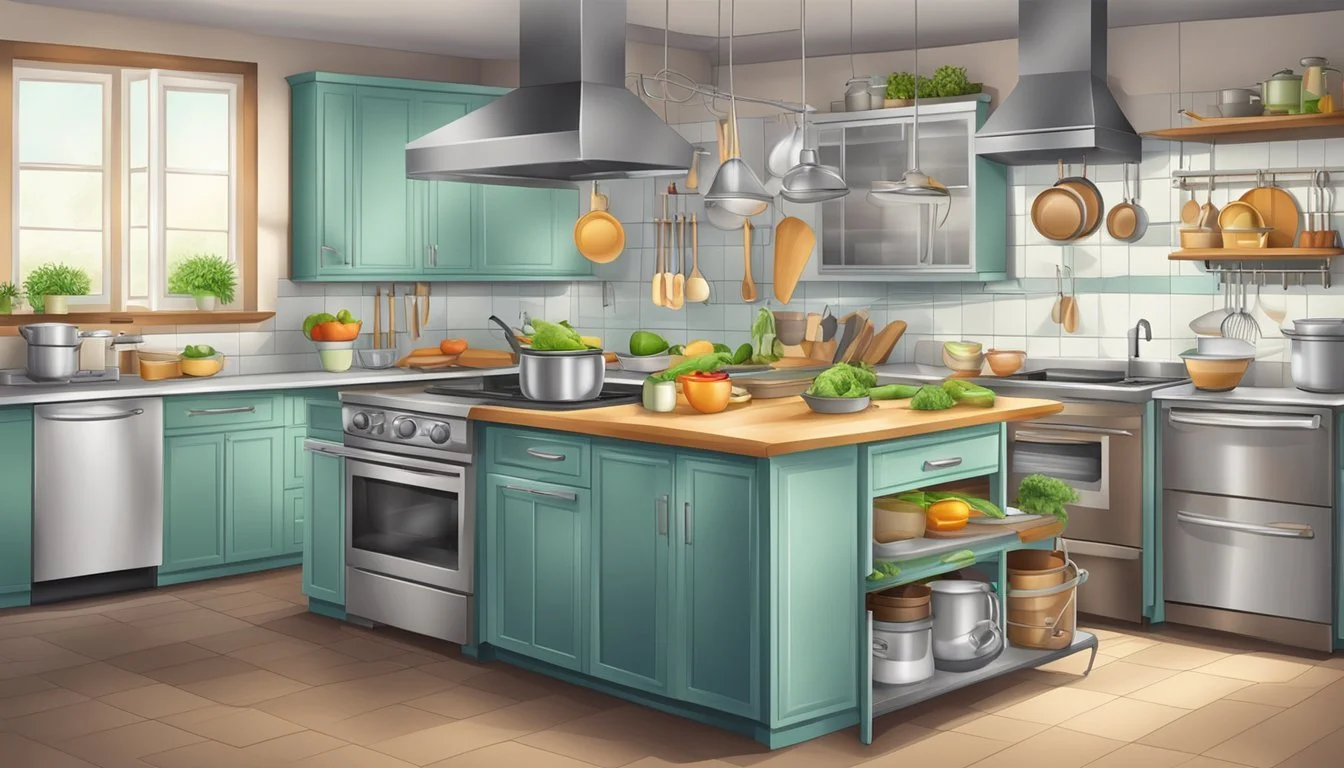Essential Cooking Terms Explained
A Comprehensive Guide for Home Chefs
Cooking terms can often seem like a foreign language to those new to the culinary world. From "al dente" to "zest," the kitchen vocabulary can be extensive and confusing. Understanding these terms is crucial for following recipes accurately and achieving the desired results in your cooking endeavors.
A solid grasp of cooking terminology empowers home cooks to interpret recipes correctly, communicate effectively about food, and execute various cooking techniques with confidence. Whether it's knowing the difference between sautéing and stir-frying or understanding what it means to "blanch" vegetables, familiarity with these terms can elevate one's cooking skills significantly.
Mastering cooking terms goes beyond just improving culinary skills. It opens up a world of culinary exploration, allowing cooks to experiment with new techniques and cuisines. By demystifying the language of cooking, aspiring chefs can approach their kitchen adventures with greater assurance and creativity.
Basic Cooking Techniques
Mastering fundamental cooking techniques is essential for any home cook. These methods form the foundation for preparing a wide variety of dishes and can be categorized into dry heat, moist heat, and combination cooking approaches.
Dry Heat Cooking Methods
Dry heat cooking uses hot air or fat to cook food without adding moisture. Baking involves cooking food in an oven at moderate temperatures, typically around 350°F. It's ideal for breads, cakes, and casseroles. Roasting uses higher temperatures to cook meats and vegetables, often resulting in a crispy exterior.
Broiling exposes food to direct heat from above, perfect for quickly cooking thin cuts of meat or toasting bread. Grilling applies heat from below, imparting a smoky flavor to foods cooked outdoors.
Sautéing involves cooking food quickly in a small amount of oil over medium-high heat. It's great for vegetables and thin cuts of meat. Searing uses high heat to create a flavorful brown crust on meats before finishing with another method.
Moist Heat Cooking Methods
Moist heat cooking uses water or steam to transfer heat to food. Boiling submerges food in water heated to 212°F, suitable for pasta and vegetables. Simmering gently cooks food in liquid just below the boiling point, ideal for soups and stews.
Poaching uses water heated to 160-180°F to gently cook delicate foods like eggs or fish. Blanching briefly cooks food in boiling water before plunging it into ice water to stop the cooking process.
Steaming suspends food above simmering water, allowing hot vapor to cook it. This method preserves nutrients and is excellent for vegetables and fish.
Combination Cooking Methods
Combination cooking methods use both dry and moist heat. Braising first browns food in fat, then slowly cooks it in a small amount of liquid. This technique tenderizes tough cuts of meat.
Stewing is similar to braising but uses more liquid and smaller pieces of food. It's perfect for creating hearty, flavorful dishes like beef stew or chicken cacciatore.
These combination methods often result in rich, complex flavors as the ingredients meld together during the long cooking process.
Preparation Techniques
Mastering various preparation techniques is essential for successful cooking. These methods lay the foundation for creating delicious dishes by ensuring ingredients are properly sized, combined, and treated before cooking.
Cutting Styles
Cutting ingredients correctly enhances texture, ensures even cooking, and improves presentation. Chopping involves cutting food into roughly equal-sized pieces. Dicing produces smaller, more uniform cubes. Mincing creates very fine pieces, often used for garlic or herbs. Slicing cuts food into thin, flat pieces.
Julienning produces long, thin strips, ideal for stir-fries. Cubing creates larger, even-sized squares. A food processor can speed up many cutting tasks. For cheese or vegetables, grating produces fine shreds.
Mixing Methods
Proper mixing techniques are crucial for achieving desired textures in recipes. Beating incorporates air into ingredients, often used for eggs or cream. Blending combines ingredients smoothly, typically with a blender or food processor.
Folding gently combines light, airy mixtures with heavier ones without deflating. Whipping introduces air to create volume, commonly used for cream or egg whites. Creaming involves beating butter and sugar until light and fluffy.
Kneading develops gluten in dough, essential for bread-making. It involves repeatedly pressing and folding the dough.
Miscellaneous Techniques
Several other preparation methods are vital in cooking. Marinating involves soaking food in a flavored liquid to enhance taste and tenderness. This process can take minutes to hours, depending on the recipe.
Grating produces fine shreds or powders from hard foods like cheese or nutmeg. It can be done with a box grater or microplane. Blanching briefly cooks food in boiling water, then plunges it into ice water to stop the cooking process.
Peeling removes the outer skin of fruits or vegetables. This can be done with a peeler, knife, or by hand for some ingredients.
Cooking Ingredients
Cooking ingredients form the foundation of culinary creations. They range from basic staples to exotic additions that can elevate a dish.
Seasonings and Flavors
Herbs and spices are essential for adding depth and complexity to dishes. Fresh herbs like basil, thyme, and cilantro provide bright, aromatic notes. Dried herbs offer concentrated flavors and longer shelf life. Common spices include cinnamon, cumin, and paprika.
Seasoning blends combine multiple spices for convenience. Examples are Italian seasoning and curry powder. Salt and pepper are fundamental seasonings found in most kitchens.
Zest from citrus fruits adds intense flavor without acidity. Garlic and onions form flavor bases for many cuisines. Vinegars and citrus juices contribute acidity and brightness to recipes.
Foundation Ingredients
Flour, sugar, and eggs are staples in baking. All-purpose flour is versatile for cakes, breads, and thickening sauces. Different sugars like granulated, brown, and powdered have unique properties.
Oils and fats include vegetable oil, butter, and lard. They're used for cooking, baking, and creating emulsions like mayonnaise.
Stocks and broths provide liquid and flavor in soups and sauces. They can be meat-based or vegetarian. Homemade versions offer superior taste to store-bought.
Dairy products like milk, cream, and cheese are crucial in many recipes. They add richness, texture, and flavor to both savory and sweet dishes.
Specialty Preparations
Roux is a mixture of fat and flour used to thicken sauces. It's cooked to varying degrees for different flavors and colors.
Dough is a mixture of flour, liquid, and often yeast. It forms the basis for breads, pastries, and pasta. The consistency varies based on the intended use.
Batter is a thinner mixture than dough, used for cakes, pancakes, and coatings. It can be thick or thin depending on the recipe.
Marinades combine oil, acid, and seasonings to flavor and tenderize meat. They're typically used before cooking.
Garnishes are decorative elements that add visual appeal and complementary flavors. Common examples include fresh herbs, lemon wedges, and edible flowers.
Cooking Actions and Finishing
Mastering cooking actions and finishing techniques elevates dishes from ordinary to extraordinary. These methods enhance flavors, textures, and visual appeal, transforming simple ingredients into culinary masterpieces.
Finalizing Dishes
Garnishing adds the final flourish to a dish. Chefs use fresh herbs, edible flowers, or citrus zest to enhance visual appeal and flavor. Dressing involves adding sauces or vinaigrettes to salads or other dishes just before serving.
Glazing creates a shiny, flavorful coating. Chefs brush meats or vegetables with a reduced sauce or syrup. This technique adds depth and a glossy finish.
Reducing concentrates flavors by simmering liquids until they thicken. This process intensifies tastes and creates rich sauces. Skimming removes excess fat or foam from the surface of soups and stocks, ensuring a cleaner flavor and appearance.
Enhancing Flavors
Seasoning is crucial for balancing and enhancing flavors. Chefs use salt, pepper, herbs, and spices to elevate taste profiles. Proper seasoning throughout the cooking process is key.
Deglazing involves adding liquid to a hot pan after cooking meat or vegetables. This releases flavorful bits stuck to the bottom, creating a foundation for sauces.
Caramelizing occurs when sugars in foods brown, developing complex flavors. This technique applies to onions, fruits, and even meats. Charring intentionally burns food surfaces, imparting a smoky taste.
Basting involves spooning hot fat or juices over food during cooking. This keeps meats moist and adds flavor. Drippings from roasted meats can be used for gravies or to enhance other dishes.
Textural Enhancements
Crisping creates a crunchy exterior on foods. Chefs achieve this through frying, baking, or broiling. It adds a pleasing contrast to softer interiors.
Coating ingredients with breadcrumbs, batter, or flour before cooking creates a crispy shell. This technique is common in fried foods and adds textural interest.
Pureeing transforms ingredients into smooth, uniform consistencies. Chefs use blenders or food processors to create silky soups, sauces, or vegetable sides.
Thickening sauces and soups improves their consistency. Methods include reducing liquids, adding starch, or incorporating egg yolks. This technique enhances mouthfeel and helps sauces cling to foods.
Culinary Vocabulary
Mastering culinary vocabulary is essential for any aspiring chef or home cook. This specialized language encompasses cooking techniques, equipment, and professional jargon used in kitchens worldwide.
Cooking Terms
Many cooking terms have French or Italian origins. "A la" means "in the style of" while "au gratin" refers to dishes topped with cheese and browned. "Al dente" describes pasta cooked to be firm when bitten.
"Cure" involves preserving food through salt, smoke, or chemicals. "Fillet" means to remove bones from meat or fish. "Knead" is the process of working dough by hand or machine to develop gluten.
"Dredge" involves coating food in flour or breadcrumbs before cooking. "Deep-fry" means to cook food submerged in hot oil, while "pan fry" uses less oil in a shallow pan.
Cooking Utensils and Appliances
A food processor is a versatile electric appliance for chopping, slicing, and pureeing ingredients. Whisks are used for beating eggs, whipping cream, and blending ingredients.
Skewers are thin metal or wooden sticks used for grilling kebabs or securing foods during cooking. Mandolines slice vegetables thinly and evenly.
Dutch ovens are heavy pots ideal for braising and making stews. Immersion blenders puree soups directly in the pot. Pressure cookers use steam to cook food quickly under pressure.
Professional Terminology
Chefs use specific terms to communicate efficiently in busy kitchens. "Mise en place" means having all ingredients prepared and ready before cooking begins.
"86" indicates an item is out of stock or removed from the menu. "In the weeds" describes being overwhelmed with orders during service.
"Leavening" refers to ingredients like yeast or baking powder that cause dough to rise. "Mother sauces" are the five basic sauces in French cuisine from which other sauces are derived.
Health and Safety Considerations
Proper food safety practices are essential in the kitchen. Always wash hands thoroughly before and after handling ingredients, especially raw meats.
Keep work surfaces clean and sanitized. Use separate cutting boards for raw meats and produce to prevent cross-contamination.
Cook foods to safe internal temperatures. Use a food thermometer to check doneness, especially for meats and poultry.
Refrigerate perishable items promptly. Don't leave food at room temperature for more than 2 hours.
When draining cooked pasta or vegetables, use caution with hot steam. Pour away from your body to avoid burns.
Greasing pans prevents sticking but can create slippery surfaces. Clean up any spills immediately to avoid falls.
Be mindful when aerating wine or other beverages. Broken glass can cause injuries.
Use oven mitts when handling hot cookware. Keep pot handles turned inward on the stove to prevent accidental spills.
Store sharp knives safely in a knife block or magnetic strip. Cut away from your body when using them.
Keep a fire extinguisher accessible and know how to use it in case of kitchen fires.





